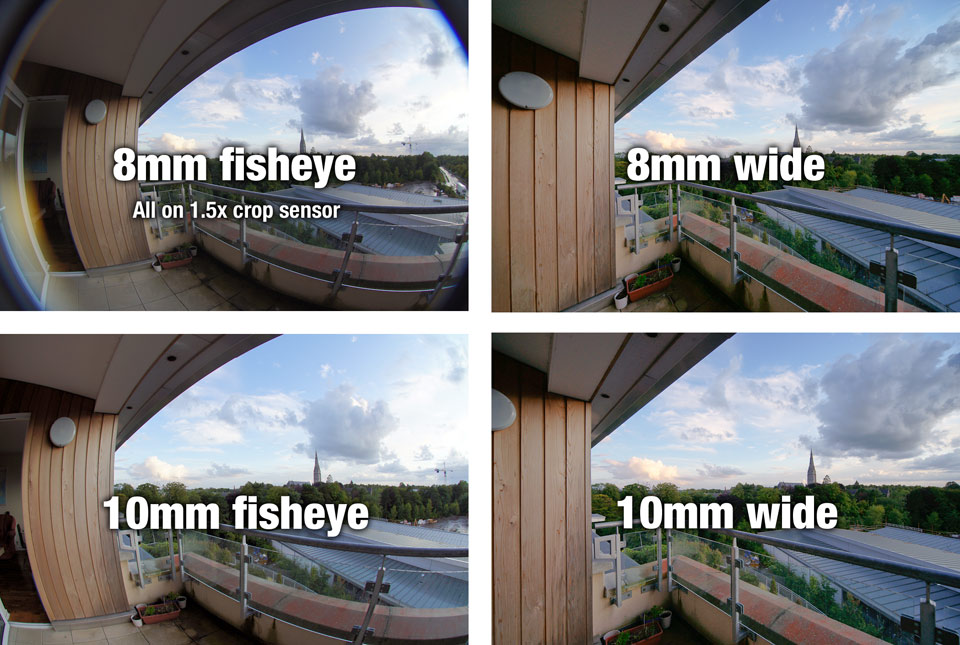
Here’s a post which is designed to save me a couple of emails per month, so please bear with me.
I often get asked (usually by people who saw my panoramic photography tutorial videos) if they can use a “regular” 8mm or 10mm wide angle lens instead of an 8mm or 10mm fisheye lens (on a camera with a 1.5x crop sensor is used) to produce full 360×180° panoramas.
The answer is: Of course you can, but you will need to take more images to cover the entire sphere. With both fisheye lenses, you can get away with as little as 4 images to cover everything — with the non-fisheyes you need a bare minimum of 12, but more like 16 shots to have captured everything.
Without wanting to get technical, this has to do with the field of view that both lens types offer (due to the different projections): The fisheye typically shows you much more than the wide angle since, grossly simplified, the fisheye “squeezes” things the more you move away from the center, whereas the wide angle lens tends to “stretch” things. In terms of numbers, both fisheyes give you a 180° field of view around the diagonal. The wide angle lenses in turn only give you 110-120°…
Click on the image above to see a quick visual comparison between the different lenses / images they produce. Pay particular attention to what is included and what is not included in the extreme corners.
Lenses used: Peleng 8mm ƒ/3.5 fisheye and Sigma 10mm ƒ/2.8 fisheye on a 1.5x crop sensor, and a Sigma 12-24mm on full frame sensor (to simulate 8mm/10mm on crop).
Hi, well it all depends on your output projection. If you are talking about full spherical panoramas (360×180°) this is not “baked” in but depends on the projection that the viewer is using at the time of displaying the panorama (meaning it can be changed interactively on the fly).
If you are talking about partial panoramas, then again it all depends on the projection and parameters that you chose (see for instance this reference: Cambridge in Colour – Panoramic Image Projections).
I recently had a comment on some of my panoramic images that they look too fisheye. After panoramic images are stitched, can someone tell the difference between a regular lense and a fisheye lense?
Don’t have the lens so can’t comment on that.
Hi Florian, how about the meike 8mm 3.5 lens, will that be good for a 360 panorama?
Hi. Using 12-24 will I has a good panorama 360 in a full frame?
@ Kenny: Yeah, that’s one way that would work. But there are also alternative patterns. Check out this handy reference.
Hi,
First of all, great videos and great website!!
I’ve just bought a 10 -20mm Sigma lens for my canon 60d crop sensor dslr. I’m planning on doing some more landscape stuff, hence the lens.
I’d like to use it for full 360/180 panoramas and you indicate I’d need 16 to 20 images. What would the format be? 2 rows of 8 plus nadir and zenit? What would you recommend?
Many thanks,
Kenny
@ Ryan: Sorry, don’t know how these lenses compare, I only have the 10mm Sigma and it’s much better than the Peleng 8mm, that’s for sure. Sorry, you’ll have to search elsewhere for a comparison.
hello m8 , hows t going ? am buyin a new fisheye lens but am not sure which fisheye 2 get , i have 2 options here: Nikon 10.5 or Sigma 10mm .. am wondering if the projection in the sigma 10mm is better? & the sigma has a wider aperture than nikon 10.5 right? not sure which one 2 get”i use Nikon d3100″… thx in advance :)
@ George: No, don’t get a 10mm, unless you have a panoramic tripod head. Get an 8mm instead. The 10mm + shaving is a very particular thing, not really recommended for a beginner, since a) it’s not easy to get the lens shaved, b) it “ruins” the lens . . .
happy to read your blogs …
if i`m to do some pano shooting i should then get the Sigma 10mm fisheye ( and remove the mask) as stated in a recent blog
I have a friend who is a photo equipment salesman and i will ask him about this.